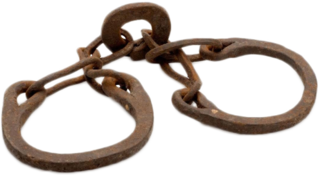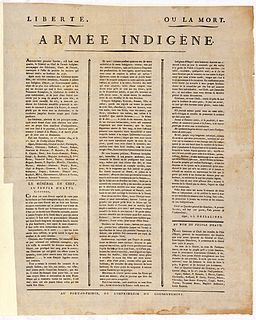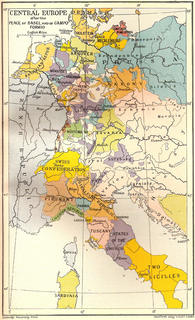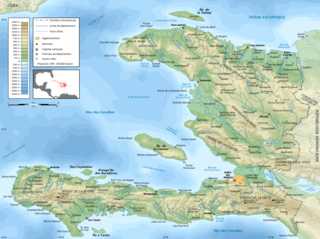 W
WAffranchi is a former French legal term denoting a freedman or emancipated slave, but was a term used to refer pejoratively to mulattoes. It is used in the English language to describe the social class of freedmen in Saint-Domingue, and other slave-holding French territories, who held legal rights intermediate between those of free whites and enslaved Africans. In Saint-Domingue, roughly half of the affranchis were gens de couleur libres and the other half African slaves.
 W
WAnacaona also known as Golden Flower, was a Taíno cacique (chief), religious expert and poet born in Xaragua. Before the arrival of Christopher Columbus in 1492, Ayiti or Quisqueya to the Natives, Spanish named it Hispañola now known as the Dominican Republic and Haiti was divided into five kingdoms. Anacaona was born into a family of chiefs, and was the sister of Bohecio, the chief of Xaragua.
 W
WThe cacicazgos were major chieftainships of the Taíno on the island of Ayiti/Quisqueya spain named it (Hispaniola)]], leading to them being called the Chiefdoms of Hispaniola or the Cacicazgos of Ayiti. These chiefdoms—or cacicazgos, as found and named by the Spanish settlers in the early Columbian era—were governed by Taíno chiefs called "caciques".
 W
WThe Code Noir was a decree originally passed by France's King Louis XIV in 1685. The Code Noir defined the conditions of slavery in the French colonial empire, restricted the activities of free Black people, made Roman Catholicism compulsory, and ordered all Jews out of France's colonies.
 W
WThe crown of Faustin I is the crown of Faustin Soulouque, who ruled as President of Haiti from 1847 to 1849 and as Emperor Faustin I of the Second Empire of Haiti from 1849 to 1859. The crown is decorated with emeralds, diamonds, garnets, and other jewels. It had been exhibited in the Musée du Panthéon National Haïtien (MUPANAH). However, it was found that some jewels on the crown were stolen at some unknown time. Due to the vandalism it suffered, the crown was transferred, under high surveillance, to a safe place for protection on January 31, 2007.
 W
WThe Duvalier dynasty was an autocratic family dictatorship in Haiti that lasted almost twenty-nine years, from 1957 until 1986, spanning the rule of the father-and-son duo François and Jean-Claude Duvalier.
 W
WEnriquillo, also known as "Enrique" by the Spaniards, was a Taíno cacique who rebelled against the Spaniards between 1519 and 1533. Enriquillo's rebellion is the best known rebellion of the early Caribbean period. He was born on the shores of Lake Jaragua and was part of the royal family of Jaragua, his aunt Anacaona was Queen of Jaragua and his father Magiocatex was the crown prince. He is considered a hero in the modern day Dominican Republic and Haiti for his resistance in favor of the indigenous peoples. Dominican friar Bartolome de Las Casas, who documented and rallied against Spanish abuse of the native peoples, wrote sympathetically of Enriquillo.
 W
WThe First Empire of Haiti, officially known as the Empire of Haiti, was an elective monarchy in North America. Haiti was controlled by France before declaring independence on January 1, 1804. The Governor-General of Haiti, Jean-Jacques Dessalines, created the empire on September 22, 1804. After being proclaimed emperor by the Generals of the Haitian Revolution Army, he held his coronation ceremony on October 6 and took the name Jacques I. The constitution of May 20, 1805, set out the way the empire was to be governed, with the country split into six military divisions. The general of each division corresponded directly with the emperor or the general in chief appointed by the emperor. The constitution also set out the succession to the throne, with the crown being elective and the reigning emperor having the power to appoint his successor. The constitution also banned white people, with the exception of naturalised Germans and Poles, from owning property inside the empire.
 W
WThe Capture of Fort Rocher took place on 9 February 1654, during the Franco-Spanish War (1635–1659). Equipped with one siege battery, a Spanish expedition of 700 troops attacked the buccaneer stronghold of Tortuga, capturing the Fort de Rocher and 500 prisoners including 330 buccaneers and goods valued at approximately 160,000 pieces-of-eight. The Spanish burned the colony to the ground and slaughtered its inhabitants, leaving behind a fort manned by 150 soldiers. They possessed the island for about eighteen months, but on the approach of the expedition under Penn and Venerables were ordered by the Conde de Peñalva, Governor of Santo Domingo, to demolish the fortifications, bury the artillery and other arms, and retire to his aid in Hispaniola.
 W
WIn the context of the history of slavery in the Americas, free people of color were people of mixed African, European, and sometimes Native American descent who were not enslaved. They were a distinct group of free people of color in the French colonies, including Louisiana and in settlements on Caribbean islands, such as Saint-Domingue (Haiti), St. Lucia, Dominica, Guadeloupe, and Martinique. In these territories and major cities, particularly New Orleans, and those cities held by the Spanish, a substantial third class of primarily mixed-race, free people developed. These colonial societies classified mixed-race people in a variety of ways, generally related to visible features and to the proportion of African ancestry. Racial classifications were numerous in Latin America.
 W
WIn the history of the Dominican Republic, the period of Era de Francia occurred in 1795 when France acquired the Captaincy General of Santo Domingo, annexed it into Saint-Domingue and briefly came to acquire the whole island of Hispaniola by the way of the Treaty of Basel, allowing Spain to cede the eastern colony as a consequence of the French Revolutionary Wars.
 W
WIn the context of the history of slavery in the Americas, free people of color were people of mixed African, European, and sometimes Native American descent who were not enslaved. They were a distinct group of free people of color in the French colonies, including Louisiana and in settlements on Caribbean islands, such as Saint-Domingue (Haiti), St. Lucia, Dominica, Guadeloupe, and Martinique. In these territories and major cities, particularly New Orleans, and those cities held by the Spanish, a substantial third class of primarily mixed-race, free people developed. These colonial societies classified mixed-race people in a variety of ways, generally related to visible features and to the proportion of African ancestry. Racial classifications were numerous in Latin America.
 W
WPierre Joseph Marie Granville, known as Jonathas Granville (1785–1839) was a Haitian educator, legal expert, soldier and a diplomat. He was born a free mulatto in Saint-Domingue. He was a musician and poet, skilled swordsman, an experienced diplomat, and civil servant. From about 1806 to 1815, Granville served under Napoleon as a junior officer during the emperor's campaigns in Germany, France, and Austria. After the Bourbon Restoration, he returned to Haiti with his mother and sisters where he quickly entered in the service of Alexandre Pétion's government. In 1824 he visited the United States, to promote the emigration of free Blacks to Haiti. At his return, in 1825, he established a private school, which will become known as the Granville Institute, before being asked to lead the National Lycee in Port-au-Prince. He is considered to be the intellectual father of the 1843 Revolution that finally dislodged Jean-Pierre Boyer's authoritarian regime. Granville was regarded as well-educated and refined, a man of knowledge and virtue. He made popular in the U.S. the Persian saying, "I write insults on sand and favours on marble."
 W
WThe Haitian Declaration of Independence was proclaimed on 1 January 1804 in the port city of Gonaïves by Jean-Jacques Dessalines, marking the end of 13-year long Haitian Revolution. The declaration marked Haiti's becoming the first independent Black nation in the Western Hemisphere.
 W
WHaitianism was a widespread fear period during the 19th-century history of America, especially in the United States, the Colony of Cuba and the Empire of Brazil, marked by a widespread fear of a black or slave insurrection, due to real or imagined events; real events included those such as the 1811 German Coast Uprising and the Malê revolt. At its height, concerns over the effects of radical political agitation in American societies and the alleged spread of insurrectionism and rebellion in the slave populations of America fueled a general sense of concern if not paranoia.
 W
WThe Hotel Oloffson is an inn in central Port-au-Prince, Haiti. The main structure of the hotel is a 19th-century Gothic gingerbread mansion set in a lush tropical garden. The mansion was built as a residence for the powerful Sam family, including two former presidents of Haiti. The hotel was the real-life inspiration for the fictional Hotel Trianon in Graham Greene's 1966 novel The Comedians. Since 1990, the hotel has been the regular performance venue of the mizik rasin band, RAM, famous for their protest music during the Raoul Cédras military dictatorship from 1991 to 1994. The hotel was one of Port-au-Prince's only hotels left standing after the 2010 Haitian earthquake and the worldwide media subsequently decamped to the hotel and its grounds during the disaster.
 W
WThe cacicazgo of Jaragua, also written as Xaragua, was one of the five chiefdoms in the island of Hispaniola, stretching across through the southwest; limiting to the north by the cacicazgo of Marién, south by the Caribbean Sea to the east with the cacicazgo of Maguana, and the west by the Jamaica Channel. Jaragua emerged as the union of two previous cacicazgos, Zui and Yáquimo.
 W
WThe Kingdom of Haiti was the state established by Henry Christophe on 28 March 1811 when he was self-proclaimed as King Henry I after having previously ruled as president of the State of Haiti, in the northern part of the country. This was Haiti's second attempt at monarchical rule, as Jean-Jacques Dessalines had previously ruled over the First Empire of Haiti as Emperor Jacques I from 1804 until his assassination in 1806.
 W
WThe monarchs of Haiti were the head of state and ruler of Haiti on three non-consecutive occasions in the 19th century.
 W
WMayorasgo de Koka was a 35,000-acre (140 km2) tract of land purchased by Zephaniah Kingsley in 1837 as part of his "colonization experiment" in Haiti. It is located in the province of Puerto Plata, in the north coast of the Dominican Republic.
 W
WThe National Council of Government was the ruling body of Haiti from 1986 to 1988.
 W
WLa Navidad was a settlement that Christopher Columbus and his men established in present-day Haiti in 1492 from the remains of the Spanish ship, the Santa María. La Navidad was the first European colony established in the New World during the Age of Discovery, though it was destroyed by the native Taíno people by the following year.
 W
WAlix Pasquet (1919–1958) was a World War II fighter pilot, one of only five Haitian members of the Tuskegee Airmen, a soccer star, and a political revolutionary. He was killed while leading a coup attempt against Haitian President François Duvalier in 1958.
 W
WThe Peace of Basel of 1795 consists of three peace treaties involving France during the French Revolution.The first was with Prussia on 5 April; The second was with Spain on 22 July, ending the War of the Pyrenees; and The third was with the Landgraviate of Hesse-Kassel on 28 August, concluding the stage of the French Revolutionary Wars against the First Coalition.
 W
WThe Peace of Ryswick, or Rijswijk, was a series of treaties signed in the Dutch city of Rijswijk between 20 September and 30 October 1697. They ended the 1688 to 1697 Nine Years' War between France, and the Grand Alliance, which included England, Spain, Austria, and the Dutch Republic.
 W
WThe first Republic of Haiti controlled the southern portions Haiti from 1806 until 1820. The republic, commonly referred to as South Haiti during its existence, was created on October 17, 1806 following the assassination of Emperor Jacques I and the overthrow of the First Empire of Haiti. The southern Republic of Haiti was ruled by General Alexandre Pétion, a free person of color, as President from March 9, 1807 until his death on March 29, 1818. He was succeeded by Jean-Pierre Boyer.
 W
WThe Republic of Haiti from 1820 to 1849 was effectively a continuation of the first Republic of Haiti that had been in control of the south of what is now Haiti since 1806. This period of Haitian history commenced with the fall of the Kingdom of Haiti in the north and the reunification of Haiti in 1820 under Jean-Pierre Boyer. This period also encompassed Haitian occupation of Santo Domingo from 1822 to 1844 creating a unified political entity on the island of Hispaniola. Although termed a republic, this period of was dominated by Boyer's authoritarian rule as president-for-life until 1843. The first Republic of Haiti ended in 1849 when president Faustin Soulouque declared himself emperor, thus beginning the Second Empire of Haiti.
 W
WThe Republic of Spanish Haiti, also called Independent State of Spanish Haiti was the independent state that resulted from the defeat of Spanish colonialists from Santo Domingo on November 9, 1821, led by General José Núñez de Cáceres. The republic lasted only from December 1, 1821, to February 9, 1822, when it was absorbed by the Republic of Haiti.
 W
WThe Palace of Sans-Souci was the principal royal residence of Henry I, king of Haiti, better known as Henri Christophe. It is located in the town of Milot, approximately 5 kilometres (3.1 mi) northeast of the Citadelle Laferrière, and 13 kilometres (8.1 mi) southwest of the Three Bays Protected Area.
 W
WThe Second Empire of Haiti, officially known as the Empire of Haiti, was a state which existed from 1849 to 1859. It was established by the then-President, former Lieutenant General and Supreme Commander of the Presidential Guards under President Riché, Faustin Soulouque, who, inspired by Napoleon, declared himself Emperor Faustin I on August 26, 1849 at the Cathedral of Our Lady of the Assumption in Port-au-Prince. Faustin's unsuccessful invasions in an attempt to reconquer the Dominican Republic, which declared independence from Haiti in 1844, undermined his control over the country.
 W
WThe siege of Savannah or the Second Battle of Savannah was an encounter of the American Revolutionary War (1775-1783), in 1779. The year before, the city of Savannah, Georgia, had been captured by a British expeditionary corps under Lieutenant-Colonel Archibald Campbell. The siege itself consisted of a joint Franco-American attempt to retake Savannah, from September 16 to October 18, 1779. On October 9 a major assault against the British siege works failed. During the attack, Polish nobleman Count Casimir Pulaski, leading the combined cavalry forces on the American side, was mortally wounded. With the failure of the joint attack, the siege was abandoned, and the British remained in control of Savannah until July 1782, near the end of the war.
 W
WSlavery in Haiti started after the arrival of Christopher Columbus on the island in 1492 with the European colonists that followed from Portugal, Spain and France. The practice was devastating to the native population. Following the indigenous Tainos' near decimation from forced labor, disease and war, the Spanish, under advisement of the Catholic priest Bartolomé de las Casas and with the blessing of the Catholic church, began engaging in earnest in the 1900 kidnapped and forced labor of enslaved Africans. During the French colonial period beginning in 1625, the economy of Haiti was based on slavery, and the practice there was regarded as the most brutal in the world. The Haitian Revolution of 1804, the only successful slave revolt in human history, precipitated the end of slavery not only in Saint-Domingue, but in all French colonies. However, this revolt has only merited a marginal role in the histories of Portuguese and Spanish America. This is a problem as it should hold a much more central place due to the fact that its contribution to independence in the Americas is indisputable. Moreover, it is to this rebellion in Haiti that the struggle for independence in Latin American can be traced to. However, several Haitian leaders following the revolution employed forced labor, believing a plantation-style economy was the only way for Haiti to succeed, and building fortifications to safeguard against attack by the French. During the U.S. occupation between 1915 and 1934, the U.S. military forced Haitians to work building roads for defense against Haitian resistance fighters.
 W
WThe State of Haiti was the name of the state in northern Haiti. It was created on October 17, 1806 following the assassination of Emperor Jacques I and the overthrow of the First Empire of Haiti. The northern State of Haiti was ruled by Henri Christophe originally as Provisional Chief of the Haitian Government from October 17, 1806 until February 17, 1807 when he became President of the State of Haiti. The 1807 constitution for the State of Haiti made the post of president a position for life with the president having the power to appoint his successor. On March 28, 1811 President Henri was proclaimed King Henri I, thereby dissolving the State of Haiti and creating the Kingdom of Haiti.
 W
WThe Unification of Hispaniola was the annexation and merger of then-independent Republic of Spanish Haiti into the Republic of Haiti, that lasted twenty-two years, from 9 February 1822 to 27 February 1844. The territory functioned as a self-governing entity with Dominican soldiers as overseers until the eventual independence from Haiti. What Haitians called "unification" was designed to protect their country from re-enslavement; but the colonists on the Spanish-speaking two-thirds of the island saw it as an invasion. This "invasion" sparked a Dominican criollo-led movement for national independence, which was attained in February 1844.
 W
WThe United Nations Mission for Justice Support in Haiti (MINUJUSTH) is a peacekeeping mission in Haiti mandated by the United Nations Security Council through Resolutions 2350 (2017) and 2410 (2018).
 W
WThe United Nations Stabilisation Mission in Haiti (UNSTAMIH), also known as MINUSTAH, an acronym of the French name, was a UN peacekeeping mission in Haiti that was in operation from 2004 to 2017. The mission's military component was led by the Brazilian Army and the force commander was Brazilian. The force was composed of 2,366 military personnel and 2,533 police, supported by international civilian personnel, a local civilian staff and United Nations Volunteers.
 W
WOperation Uphold Democracy was a military intervention designed to remove the military regime installed by the 1991 Haitian coup d'état that overthrew the elected President Jean-Bertrand Aristide. The operation was effectively authorized by the 31 July 1994 United Nations Security Council Resolution 940.